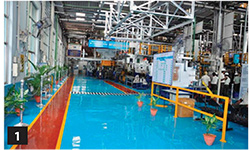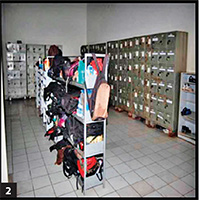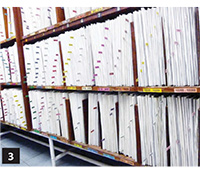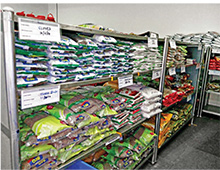Story by T Murrali
Five S, the concept listing five Japanese words – Seiri, Seiton, Seiso, Seketsu and Shitsuke, has been in vogue for many years in India with both vehicle makers and parts suppliers. However, its implementation depends upon the size of the organisation; their vision and mission. While a matured level of realisation can be seen in companies with Japanese and Korean connections, it is largely missing in small and medium enterprises. Nevertheless, the scope is wide for organisations to extrapolate this concept from beyond the shopfloor to the office, canteen and scrapyard.
The transliterated Japanese concept 5S stands for Sort, Set, Shine, Standardise and Sustain. It typically describes how to organise the work place for efficiency and effectiveness by identifying and storing the items used, maintaining the area, and sustaining the new order.
According to information available in the public domain, the history of 5S goes back as far as the 16th century with some shipbuilding companies streamlining the assembly process to up productivity. However, there is enough evidence to show that this concept was prevalent in India much earlier, going back a few centuries.
Subscribing to this view Dr Ravichandran, Executive Director, Lucas-TVS says that 5S has been practised for several centuries in India at many religious places – having designated places for specific purposes, prayers etc. There is a place for everything, and everything is always in that place. He also pointed out that there are innumerable axioms reiterating the fact that cleanliness is next to godliness and wealth. “I would rather extend it and state that cleanliness ultimately leads to comfort; the objective of 5S is to remove waste,” he said.
The 5S process is one of the most fundamental and widely applied components of lean manufacturing. Its application is simple, making use of basic common sense; however, the advantages cannot be underestimated due to its simplicity. Once implemented, the system can be the stabilising force underlying a lean manufacturing strategy. It is said that Sakichi Toyoda and son Kiichiro as well as Toyota engineer Taiichi Ohno fine tuned certain systems and developed the 5S methodology, which became part of the Toyota Production System; it offered each employee a level of importance and encouragement that every job was essential to the process to get the desired end product.
Ravichandran explained the sequence in which the 5S concept has been developed. Once things are sorted out, it is necessary to set them in order, followed by shining or cleaning. All these three aspects need to happen every day and, therefore, these need to be standardised as a system; and these practices have to be sustained to achieve better results. “The moment anything is touched we can feel abnormalities, if any; and addressing it will prevent disaster. Always, systems should take over, and not people. People are not systems but they create them. Unfortunately, in many organisations in India, systems do not exist and that is why organisations do not function properly in the absence of the top man,” he opined.
According to Ramesh Suri, President, Automotive Components Manufacturers Association of India (ACMA), 5S is the cornerstone of any lean manufacturing implementation, whether applied in manufacturing, office process or even within a service industry. ACMA’s technical/learning centre ACT (ACMA Centre for Technology) has been driving 5S execution in cluster programmes for the auto component sector since 1999. It is typically a methodical team-based approach to organise tools ergonomically, in a tidy and organised manner. Without proper implementation of 5S, no facility or company can move forward to attain manufacturing excellence. “The system is applicable to all areas and processes and not mere manufacturing,” he asserts.
The primary objective of 5S is to create a clean, orderly surrounding, and an environment where everything is in its designated place. Beyond this, many companies begin their lean transformation with 5S because it exposes some of the most visible examples of waste besides, helping to establish the framework and discipline required to successfully pursue other continuous improvement initiatives. The guiding principles underlying the system involve organising, cleanliness and standardisation. Overall workplace cleanliness is created by removing waste from the work area; it promotes internal organisation and enhances visual communication. By reducing wasted time and materials, productivity is increased along with safety, and costs are reduced.
Srivats Ram, Chairman, ACT views that 5S is fundamental to any organisation as it brings in visual change. While making any intervention in a manufacturing plant it is precisely looking at changing the mindset. From the psychological point of view it is the easiest way to change attitude as it changes the visual picture itself. “If this is achieved, then those people will feel that genuinely things have changed; it will make everyone willing to be part of the change.”
Ram continues that this concept had originated from Japan due to the plethora of constraints that they had; besides, they developed a culture of continuous improvement, which helped them in building competence in manufacturing and related aspects.
“Most of the concepts have evolved from Eastern countries. We have over a period of time tweaked the concept so that it works towards our culture in India. This is because Indians, typically, like to think on their own. In some ways this can be a deterrent but it also means that there is a potential to unlock the initiatives that people can take. It is more of engaging people, which grows to ownership and pride.” 2 In terms of productivity and cost the advantages are numerous; it ensures that the time lost in searching for tools etc can be reduced, explains Ram.
Acknowledging this view Sarangarajan, Vice President – Production, Hyundai Motor India, looks at this concept as a tool to make the workplace most pleasing for workers, and not just for presentation to visitors. “Employees should feel that it is a great place to work in. If everything is arranged in a predetermined fashion, the chances of mishaps, due to wrong positioning of things, can be eliminated. Hyundai believes in this and does not hesitate to invest on things that are required to maintain 5S.”
















Leave a Reply